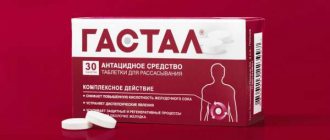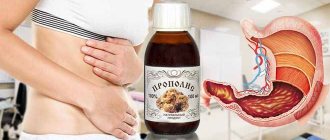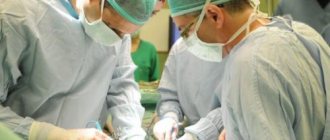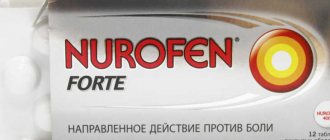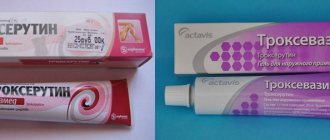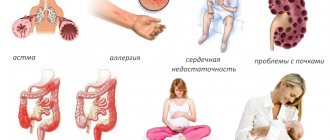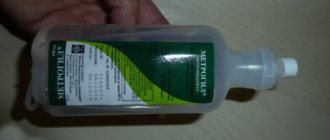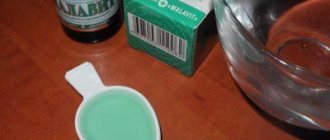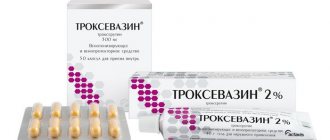Phosphalugel instructions
Phosphalugel is an antacid drug that has acid-neutralizing, enveloping and adsorbing effects, reducing the proteolytic activity of pepsin and without causing alkalization of gastric juice, maintaining the acidity of the stomach contents at a physiological level and does not lead to the activation of hypersecretion of (secondary) hydrochloric acid.
Its mechanism of action is based on the formation of a protective layer of the mucous membrane of the digestive tract (stomach and intestines), which contributes to the passive removal of gases, toxins and pathogenic microorganisms, normalizing the altered motor and evacuation function of the gastrointestinal tract. It reduces the symptoms of heartburn, sour belching and heaviness in the stomach in functional and organic (including infectious-inflammatory) diseases, mainly of the upper parts of the digestive system.
https://www.youtube.com/watch?v=e56aYFG2hzY
The main feature that determines the duration of action of Phosphalugel is the high adhesive ability of aluminum phosphate micelles on the walls of the stomach, maintaining acidity at 2.4 for two hours with a gradual decrease as the active substance dissolves, which is considered to prevent acid rebound (arising in connection with rapid inactivation of the antacid drug).
Phosphalugel is available in the form of a 20% gel for oral administration (packaged in sachets), homogeneous after mixing, white in color with orange flavor with a total weight of one sachet - 16 and 20 grams, depending on the content of the active ingredient - aluminum phosphate in one sachet - 2 , 08 (2.48) grams.
Phosphalugel is prescribed in adults and children with mandatory dosage and frequency of administration in order to avoid side effects of the drug - constipation (especially in elderly patients and bedridden patients) or allergic reactions (in case of intolerance to aluminum phosphate or auxiliary components of the gel).
When taking this antacid drug simultaneously with antibacterial drugs (tetracycline antibiotics and fluoroquinolones), cardiac glycosides, anti-inflammatory drugs, antihypertensive drugs, iron supplements, taking these drugs is possible only two hours after taking Phosphalugel, due to its pronounced enveloping activity .
When is the drug indicated?
In what cases is it advisable to use phosphalugel? The drug is prescribed for certain pathological conditions in the body after poisoning.
- The presence of peptic ulcers of the stomach and other organs of the digestive tract,
- Diarrhea,
- Inflammatory processes of the duodenum,
- Overdose of alcoholic beverages, chemicals,
- Inflammation of the mucous membranes of the stomach,
- Diaphragmatic hernia,
- Disruptions in the functionality of the digestive system,
- Intestinal diseases,
- To limit the absorption of radioactive substances in the stomach.
Phosphalugel is indicated for food and drink poisoning.
The best enterosorbents
The mechanism of action of enterosorbents is physical. All of these products have a very large surface area with a small volume because they have a porous structure. These pores absorb excess intestinal gas, bind it and remove it from the body. Sorbents are usually used as a short course, since along with gases they can absorb nutrients, microorganisms and other useful components.
It is very important to remember that all sorbents must be taken separately from meals and other medications so that they do not inactivate and reduce the medicinal benefit. Therefore, the ideal option is to take sorbents 2 hours after a meal or 2-3 hours before a meal, in a state of as empty a stomach as possible. Let's consider the most popular representatives of enterosorbents, included in the rating of means to combat flatulence and bloating.
Polysorb MP
Rating: 4.9
Polysorb MP is a very light, weightless snow-white powder, which consists entirely of silicon oxide, highly dispersed. Its particle sizes do not exceed 0.01 mm, and its adsorption capacity is very high. 1 gram of silica can absorb 300 mg of other substances, that is, take on and remove a third of its own weight from the body.
This allows it to be used as an intoxicant and a drug to improve immunity. In addition to flatulence, Polysorb MP is indicated for intestinal infections in the recovery stage, intoxication, food and drug allergies, and poisoning, including alcohol. Polysorb is used in the presence of jaundice, as a means of prevention for those living in environmentally unfavorable areas, for persons exposed to periodic exposure to various doses of radioactive radiation. Polysorb MP is used to increase adaptation in people with increased physical and mental stress and sports practice.
The drug is used only mixed in water. The suspension must be prepared before each dose. Adults need to take from 6 to 12 grams per day in 3 divided doses, for example, 3 grams per dose. The official instructions for the drug contain a dosage table, and from these tables, depending on the patient’s body weight, you need to calculate how many spoons you need to take for dilution with water.
What medicine will help a child if his stomach hurts?
What to do if a child has a stomach ache, what can be given to make the pain go away? Parents whose children are in any age category may encounter this problem. There can be many reasons why a child has a stomach ache. This could be dysbacteriosis, which often occurs in infants, or pain associated with the penetration of parasites into the body of children. In any case, to eliminate pain symptoms, it is important to determine the cause that caused them.
- 1What to do if a newborn has a disease
- 2How to treat pain caused by poisoning?
- 3Effective medications
- 4Folk remedies
- 5Activated carbon
1What to do if a newborn has a disease
What to do if your newborn baby has a stomach ache? Firstly, the mother needs to calm down, since her nervous state will not have the best effect on the child’s well-being. Secondly, you should understand that the most common cause of abdominal pain in infants is so-called colic. Manifestations of flatulence in young children are quite easily explained by the fact that their gastrointestinal tract and enzymatic system are still in the development stage and simply cannot cope fully with the incoming food. This is especially pronounced when complementary foods are introduced early or if the child is bottle-fed.
How to treat such a manifestation? From many mothers you can hear the words “in such cases I give dill water.” Indeed, this folk remedy has a good effect in many cases. Dill water can be purchased at pharmacy chains or prepared at home yourself. Water prepared with dill will help get rid of muscle spasms in the intestinal tract and promote the rapid passage of food and gases.
Often young mothers complain that folk remedies do not cope with the task. Then medications come to the rescue. Any medicine from the “colic” series is sold in a pharmacy without a doctor’s prescription, but it is still recommended to consult a specialist. Only a pediatrician who has personally examined the child will be able to correctly select the right medication and prescribe a regimen for its administration.
Most often, for infant flatulence, carminatives are used, such as:
- Bobotik;
- Espumisan;
- BabyCalm;
- Bebinos;
- Plantex.
All these means allow you to quickly get rid of gases, driving them through natural pathways.
In addition to such drugs with a carminative effect, doctors prescribe antispasmodic medications. Taking them can significantly improve the well-being of a small child. Similar antispasmodics include No-shpa and Drotaverine. But their use must be supervised by a pediatrician.
In addition, manifestations of dysbacteriosis require the use of medications that contain lacto- and bifidobacteria.
Of course, parents should not immediately resort to using various medications to get rid of colic, since there are many ways to rid the baby of excess gas formation, including massaging the tummy, placing the baby on his stomach, the mother reviewing her diet in order to exclude foods from it, promoting increased gas formation.
2How to treat pain caused by poisoning?
As a child grows up, he tries more and more new food products, but his intestinal tract does not always have time to adapt to the products offered for processing. Quite often, it is the child’s body that reacts to new or “contaminated” products with toxins and microorganisms most acutely compared to the adult’s body.
Signs of poisoning are quite easy to differentiate from symptoms of other diseases, in particular these are:
- acute abdominal pain;
- vomit;
- diarrhea;
- rise in temperature;
- weakness;
- dehydration.
How to help a child with poisoning, what can you give him during this period? We should start with the fact that first aid for poisoning does not begin with the selection of medications. Before deciding what can be given to a suffering child, you must complete the first point of the following algorithm:
- Step 1 - gastric lavage;
- Step 2 - taking enterosorbents;
- Step 3 - maintaining a drinking regime;
- Step 4 - colon cleansing.
Before giving your child any of the medications in your home medicine cabinet, he needs to rinse his stomach. To do this, you need to make sure that the child drinks about 1.5 liters of water. Of course, in most cases, the suffering baby will refuse, fearing that it will get even worse, but this must be done. Next, you should provoke vomiting in the child by putting your finger in his mouth and lightly pressing on the root of the tongue. In addition, you can first add 1-1.5 tbsp to the water. l. soda
It is important to remember that such washing is only permissible for children over five years of age. For children under 5 years of age, rinsing is performed only in a hospital using a special probe.
What can be given for abdominal pain after rinsing? The answer to this question will be the next step of the algorithm of actions described above. Enterosorbents are special medications that can be taken to reduce the concentration of toxins in a child’s body. The following sorbents can be used to treat children from the first days of life:
- Polysorb;
- Enterosgel;
- Smecta;
- Polyphepan.
When using enterosorbents, it is important to consider the dosage and the fact that the drug should be prescribed by a specialist. As a last resort, you can consult with an ambulance paramedic.
The third step in case of poisoning is to provide the child with plenty of fluids. At this stage, the child should be given as much fluid as possible to replace fluid loss caused by diarrhea or vomiting. Drinks may include:
- green and black tea;
- still mineral water;
- pharmaceutical saline solutions.
The next step involves performing a cleansing enema. In case of serious poisoning or parents lack confidence in their own abilities and the correctness of the procedures, it is better to seek professional medical help by calling an ambulance.
3Effective medications
Quite often, a child's complaints of abdominal pain are actually complaints of stomach pain. What to do if your child has a stomach ache? It is necessary to be guided by reliable information about the causes of pain. And for this you should be examined by a doctor.
The most common cause of stomach pain in children is gastroduodenitis. Treatment of pain caused by the manifestation of this pathology should be recommended by a doctor only after the child has undergone a special diagnostic examination. In general, the big task of normalizing the child’s condition is assigned to a special diet.
What can you give a child with manifestations of gastritis? What remedies will be most effective? First of all, preference is given to agents that can reduce the acidity of gastric enzymes. These medications belong to the antacid group:
- Almagel (prescribed from the 2nd month of life);
- Maalox (prescribed from the 4th month of life);
- Megalac (prescribed from 12 years of age);
- Phosphalugel (prescribed from 12 years of age).
Each of the listed products contains magnesium and aluminum, which “quench” acid. Taking such drugs is allowed strictly as prescribed by a doctor, as well as in compliance with the recommended doses half an hour before meals or an hour after it.
Further, it is possible to use drugs that are intended to reduce the secretion of gastric juice. These are medications:
- Ranitidine (from 12 years old);
- Zantac (from 12 years old);
- Gistak (from 12 years old).
The use of any of the drugs indicated above requires a doctor’s prescription and further monitoring on his part of the condition of the little patient.
If we talk about symptomatic treatment for manifestations of gastritis, it should be noted that such treatment, as a rule, is prescribed by a doctor for no more than a week. In this short period of time, it is important to adhere to the doses and dosage regimens recommended by the specialist. In general, treatment involves taking 3 types of drugs: choleretic drugs, drugs that promote the movement of food through the intestines, and biological products.
4Folk remedies
For abdominal pain in both adults and children, you can use traditional medicine, but this must be done with caution, since it is the child’s body that can respond in an unpredictable way to the use of traditional recipes.
Probably the most delicious and healthy way is to treat pain with honey. But such a remedy can only be used if you are completely sure that the child is not allergic to honey and bee products. Taking honey helps reduce acidity in the stomach, eliminate heartburn, and heal ulcers and erosions. A child needs to take 20 g of honey, diluted in 1/3 glass of warm water. You should drink honey water at least an hour before meals or 2.5-3 hours later.
For abdominal pain, you can give your child chamomile tea. To do this, you need to brew a chamomile-colored bag in a glass of boiling water and let it brew. This tea will not only relieve severe pain in the stomach, but also normalize the child’s nervous state.
In addition to honey and chamomile, one of the remedies available to almost every housewife that can be used is lemon. The juice of half a lemon is diluted in warm water. This remedy can be drunk throughout the day.
For pain caused by gastritis with low acidity, the child can drink half a glass of currant juice three times a day.
You can use warm cabbage juice using the same scheme.
The herbal mixture prepared from 3 parts of dandelion root and 1 part of fennel fruit also receives good reviews. Mixture in the amount of 1 tbsp. l. pour 1 cup of boiling water. The infusion is prepared within 20-25 minutes. You need to drink half a glass up to 3 times a day, half an hour before meals.
5Activated carbon
The most popular remedy used for abdominal pain in our country is regular activated carbon. But can it be given to children? The answer to this question will be in the affirmative; it is only important to know the intricacies of taking activated carbon.
Activated carbon can be used in the treatment of children of any age, including infants. If the use of this drug is necessary when carrying out therapeutic measures on infants under 1 year of age, the tablets must be dissolved in water. The dose is divided into 4-5 doses throughout the day.
In general, the amount of activated carbon consumed depends on the child’s weight.
In most cases, the intake of activated carbon occurs in accordance with the scheme: 3-2-2. What does it mean? It's quite simple. You need to drink charcoal 3 times a day, 2 hours before meals or 2 hours after them. This scheme is quite reasonable. Being a sorbent, activated carbon not only removes substances harmful to the body, but can also capture useful ones. This is why taking activated charcoal should not be combined with taking food or other medications.
It is best to use activated charcoal for pain caused by poisoning or disruption of the gastrointestinal tract. It is better to abolish the use of activated carbon for dysbiosis; in this case, probiotics will be more beneficial.
Treatment using activated carbon in the vast majority of cases does not exceed 5-7 days. Excessive use of activated charcoal can cause constipation in a child. Coloring stool black is considered normal.
Source: pitanie.gastrit-i-yazva.ru
Phosphalugel application
Phosphalugel is taken in pure form or diluted before use in half a glass of water, first kneading the contents of the sachet with your fingers until a homogeneous gel is obtained.
For adult patients, adolescents and children over six years of age, Phosphalugel is prescribed one or two sachets two to three times a day.
For reflux (gastroesophageal and reflux esophagitis) and diaphragmatic hernia, Phosphalugel is taken immediately after meals and at night.
For ulcerative lesions of the stomach and duodenum (peptic ulcer), this drug is prescribed one to two hours after meals and/or when pain occurs.
For gastritis with high or normal acidity and functional dyspepsia (non-ulcer origin), Phosphalugel is taken before meals, and for functional diseases of the large intestine (irritable bowel syndrome) on an empty stomach in the morning and at night.
If pain occurs in the epigastric region between the use of the drug, the administration of Phosphalugel is repeated.
Contraindications to the use of this drug are impaired renal function, individual intolerance to the components of the drug and cirrhosis of the liver.
Contraindications
Phosphalugel should absolutely not be used in the following cases:
- Kidney dysfunction and chronic urinary tract diseases;
- Hypersensitivity to individual components of the drug in question.
People who:
- Suffer from diseases of the cardiovascular system;
- Patients with cirrhosis of the liver;
- They are in old age.
Side effects in the case of correct use of the drug in question for bloating are rare. However, older adults may experience constipation and heartburn. In such cases, it is recommended to increase your daily water intake. Long-term consumption of Phosphalugel is not recommended without the approval of the attending physician.
https://youtu.be/JnuS6ZkW8cI
BEST defoamers and enzymes
The name itself - defoamers - speaks of the way in which drugs fight flatulence. They simply reduce the bubbles of foam, and after the peristaltic wave passes through the intestines, the mixture of these bubbles decreases, whereas under normal conditions it beats more strongly, fills the lumen of the intestine, inflates and stretches the mesentery on which the intestine is attached.
This usually leads to the development of pain with bloating. When the foam is eliminated and does not interfere with the passage of intestinal contents, there is no longer any pain syndrome or excessive gas formation. There are few drugs in this class. All of them contain either simethicone or dimethicone, as well as additional ingredients.
Rating: 4.9
The most popular drug from the group of products containing simethicone is Espumisan, which is produced by the German pharmaceutical company. Espumisan is simethicone in its pure form, and its task is to reduce surface tension at the foam/air phase interface. By reducing surface tension, bubbles lose the ability to fragment, expand and merge with each other. They, on the contrary, collapse, being small, and the gas comes out in small volumes and natural portions.
Espumisan is indicated for a variety of conditions accompanied by bloating and flatulence. These are functional gastrointestinal disorders, irritable bowel syndrome, chronic pancreatitis, dyspepsia. Espumisan is also used if the patient is undergoing an examination, for example an ultrasound.
It is known that gas bubbles greatly complicate the construction of an image, and Espumisan eliminates these defects. Espumisan is taken orally during meals or after meals, and if necessary, at night. For bloating and flatulence, and for a feeling of fullness, taking one to two capsules up to 5 times a day is recommended for adults and children over 14 years of age. The product is available in capsules, and the average cost of a package of 50 capsules of 40 mg is 440 rubles.
Schemes and dosages by age
The medication is intended for oral administration. To obtain the necessary therapeutic result, it must be taken on an empty stomach half an hour before meals. The recommended dose depends on the age of the child:
- Adolescents over 12 years old – 2 sachets 3 times a day.
- Ages from 6 to 12 years – 1 sachet 3 times a day.
- Children from six months to 6 years – ½ sachet (2 teaspoons) 3 times a day.
- Children from birth to 6 months – ¼ sachet (1 teaspoon) 3 times a day.
The duration of the course of therapy is determined by the severity of the pathology. It is determined individually by the attending physician. Occasional medication is allowed to reduce the manifestations of functional disorders.
Rules for treating infants
The use of the drug for children under six months of age is allowed in a dosage of ¼ sachet (1 teaspoon or 4 g of gel). Indications affect how much and for how long you can take the drug:
- Treatment of regurgitation and diathesis includes the administration of medication 4 g 6 times a day for 5-10 days.
- Flatulence (bloating) and intestinal colic - occasional use of the medication is allowed as needed. After gas begins to pass and signs of bloating disappear, use of the drug is discontinued.
- Food poisoning - the drug is prescribed in an age-appropriate dosage for 2-3 days.
Phosphalugel indications
Indications for the use of Phosphalugel are:
- for peptic ulcers of the stomach and duodenum;
- for gastritis with high or normal acidity;
- with duodenitis;
- for colopathy, sigmoiditis, enteritis;
- with reflux esophagitis, gastroesophageal reflux, which are accompanied by heartburn and belching;
- diaphragmatic hernia;
- irritable bowel syndrome with a tendency to diarrhea;
- for gastrointestinal disorders caused by taking irritating substances or medications, alcohol and other intoxications;
- for dyspepsia of non-ulcer origin;
- for neurogenic dyspepsia with severe symptoms - heartburn, belching and gastralgia.
Phosphalugel for children
In pediatric practice, Phosphalugel is used for gastritis with high acidity, gastric and intestinal ulcers and reflux esophagitis, which are accompanied by severe dyspeptic symptoms - heartburn, belching and pain.
For children over six years of age, the drug is prescribed one sachet two to three times a day and at night.
For children under six months with severe reflux, clinically manifested by frequent regurgitation, Phosphalugel is prescribed ¼ sachet or one teaspoon after each feeding, and for babies over six months of age - ½ sachet or two teaspoons after feeding.
With long-term administration of anticidal agents containing aluminum hydroxide, the absorption of phosphates from food products in the intestine is disrupted, with the subsequent development of hypophosphatemia, osteoporosis and osteomalacia. In this regard, the use of aluminum-containing antacids in children and pregnant women is limited, except for Phosphalugel, which contains aluminum phosphate and does not affect phosphorus-calcium metabolism. Therefore, it is prescribed to children from birth, women at any stage of pregnancy and nursing mothers.
Phosphalugel is not contraindicated for use in pregnant women in therapeutic dosages as prescribed by the attending physician and under his supervision. The duration of treatment is determined by the nosological form of the disease, the severity of symptoms and concomitant diseases.
Indications for the use of Phosphalugel in pregnant women are exacerbations of chronic gastritis, peptic ulcer with heartburn, belching and severe pain, reflux esophagitis and gastroesophageal disease, neurogenic and functional dyspepsia that occur against the background of hormonal imbalance and severe functional diarrhea.
Phosphalugel is not used if the functional state of the body's excretory system (urinary system) and liver is impaired.
Phosphalugel price
The cost of Phosphalugel ranges from 311 to 320 rubles per package (16 gram bags No. 2x10).
Phosphalugel reviews
Phosphalugel is a modern and effective antacid drug with an active substance - aluminum phosphate, which, unlike other aluminum-containing antacids, is approved for use in children from birth, lactation and pregnant women. It does not cause metabolic and mineral disturbances (phosphorus and calcium), is not complicated by the deposition of calcifications in various organs and renal tubules, and does not cause osteoporosis and osteomalacia due to hypophosphatemia.
Almagel - extensive instructions (price, reviews)
Alfogel instructions
Hefal instructions
Riopan instructions
Espumisan: Instructions, prices, reviews
Taking the drug by children
Phosphalugel has no age restrictions, so it can be used in case of poisoning even in newborn babies. Dosage for children is calculated based on the age of the small patient.
- For infants, a quarter of a sachet of gel is considered the norm.
- For a child aged six months to six years, the dosage is half a sachet up to four times a day.
- Phosphalugel in case of poisoning to children under twelve years of age can be given a whole package four times every twenty-four hours.
- Over the age of twelve years, the dosage is equal to that of an adult.
Children should not use the product for a long time due to the adverse effects of aluminum (as part of the product) on the development of the baby. Taking it for two to three days does not cause side effects.
The best probiotics, eubiotics
Finally, there is a group of biological drugs that fight excess gas and bloating in a special way. They simply compete for the food environment with pathological microorganisms, which stimulate excess gas formation. If a person has normal microflora in the intestines, and there are no signs of severe dysbiosis, then it will very quickly cope with gas formation.
The use of these drugs has a positive effect not only in the presence of any disease, but also in the case of preventive use, as food additives. They enhance immunity, stimulate the body's nonspecific resistance to bacterial and viral infections, and even promote active antitumor activity.
If a person switches to a different diet, then the administration of probiotics and eubiotics allows him to make this transition painlessly and without consequences. What is the difference between prebiotics and eubiotics? Probiotics are substances that do not contain beneficial microorganisms, they only contain traces of their vital activity and a nutrient medium.
They facilitate colonization by normal microflora. Such drugs include Hilak forte. After it has been taken for some time, eubiotics, that is, directly living “embryos” of beneficial microbes, can be prescribed. What microbial preparations can effectively combat bloating? Here are some of them.
Hilak forte
Rating: 4.9
Hilak forte, which is available in drops, contains metabolic products of normal intestinal microflora. This is a special environment that is produced by Escherichia coli, fecal streptococci, as well as some types of lactobacilli. As a result, this environment has protective properties against normal microflora, and is an aggressive environment against pathogenic microorganisms.
While taking Hilak Forte, normal microflora is restored much faster after taking antibiotics, various acute intestinal infections and disturbances in the water-salt balance in the intestines. In addition to bloating and impaired intestinal motility, the drug is indicated as a remedy for the correction of dysbiosis, for diarrhea and functional constipation, for gastritis with reduced secretion, as well as for various allergic skin lesions.
special instructions
Before using the medication, it is important to read the instructions and pay attention to several special instructions.
The use of the medication is excluded if there are absolute contraindications. These include individual intolerance, allergy to any of the components of the drug, chronic constipation of various etiologies, abdominal pain of unknown origin, Alzheimer's disease.
The drug may cause constipation and allergic reactions. If the recommended therapeutic dose is significantly exceeded, the child’s passage of food through the intestines is disrupted, leading to the development of constipation. In this case, symptomatic treatment is prescribed.
If constipation occurs while taking the drug, doctors recommend increasing fluid intake. Phosphalugel does not affect X-ray examination and can be used in combination with other medications. Doctors do not recommend taking the medicine for a long period, and you should not use it systematically.
Phosphalugel is a safe drug, but many still prefer to use cheaper analogues of drugs that may have an identical composition or have the same mechanism of action. Popular analogues of the drug include Almagel, Gasterin, Gastal, Rennie. Before purchasing any analogue, you need to consult with a specialist and carefully study the instructions for use.
Excess gases in the body
Flatulence is a feeling of discomfort inside the intestines due to a large accumulation of gases in it. When the organs of the digestive and gastrointestinal tract are not functioning properly, bloating often manifests itself. In some cases, profuse belching and cramping pain appear. Depending on the cause of the illness, a person may feel nausea, heaviness in the stomach, bloating in the abdomen, dizziness and weakness.
Bloating is a sign of flatulence
This phenomenon is not a specific disease, but a symptom of some disease or disorder in the functioning of organs. With flatulence, an abundance of gases is produced while their elimination is minimized. Accordingly, an imbalance appears, which manifests itself quite painfully and unpleasantly for both the patient himself and those around him.
Causes of flatulence
The causes of flatulence are varied. And treatment of this symptom should be aimed at eliminating the factors underlying it.
Conventionally, depending on the reasons, flatulence is divided into several types:
- Nutritional. This is the result of eating foods rich in starch and fiber.
- Dynamic. In this case, a violation of motor function in the gastrointestinal tract occurs. Often the basis of such flatulence is infectious diseases.
- Psychogenic. It occurs against the background of any mental abnormalities.
- Circulatory. It manifests itself due to disturbances in blood circulation due to varicose veins.
- Dysbiotic. Its basis is the development of enzymatic deficiency and dysbacteriosis.
In cases where increased gas formation is not a consequence of poor nutrition, it is necessary to undergo a diagnostic examination. Only by knowing exactly the reasons can you get rid of flatulence.
Maalox for stomach damage
Maalox gel helps with abdominal pain.
The milky substance is characterized by an adsorbing effect. Belongs to the group of antacids. The composition includes weak alkalis in the form of magnesium and aluminum hydroxide. During decomposition, carbon dioxide is not released, which is considered one of the advantages of the product. But often patients have the question of which is better: Maalox or Phosphalugel. The first type of drug works faster. Attacks of nausea, heartburn and pain disappear instantly. Maalox keeps the pH balance of gastric juice normal longer.
Phosphalugel is considered a safer product, so it should be taken during pregnancy and breastfeeding for a long time. This is explained by the fact that it does not wash away important microelements from the body in the form of potassium, magnesium and phosphorus.
Maalox is available in a ready-to-use suspension. The dosage is indicated in the instructions. The medicine should be taken 1 hour before meals.
But there are a number of contraindications such as:
- lack of phosphorus and magnesium in the body;
- liver and kidney failure;
- children under 15 years of age;
- diseases of the central nervous system.
Before use, you should exclude the presence of contraindications, otherwise side effects will develop.
Treatment
If the patient’s condition is not dangerous and emergency hospitalization is not required, then all treatment is carried out at home using therapy prescribed by the doctor.
Any drug treatment requires preliminary diagnosis. taking an anamnesis is the first step
Under no circumstances should you self-medicate.
The main drug treatment for flatulence is divided into groups:
- symptomatic;
- pathogenetic;
- etiotropic therapy.
Treatment of symptoms is the complete elimination or reduction of pain that occurs against the background of increased tone of the smooth muscles of the gastrointestinal tract. As a rule, antispasmodics are used in these cases. They slightly dilate the vessels of the hematopoietic system, reduce the tone of tense muscles, thereby easing the general condition of the patient.
Medicines to help get rid of flatulence
Etiotropic treatment
Etiotropic treatment is aimed at eliminating the causes that contribute to increased gas formation. If the basis of flatulence is constipation, then mild laxatives are recommended. When there is a violation of intestinal motor functions, stimulants are prescribed that enhance peristalsis and prevent vomiting.
The simplest drug for flatulence is activated carbon. Often, with flatulence, it is enough to take a few tablets of this medicine. However, you should not place high hopes on it, because coal is only an absorbent
There is pathogenetic therapy, the essence of which is the fight against increased gas formation. This treatment normalizes metabolic processes in all organs of the gastrointestinal tract, preventing bloating and eliminating excess gas formation. In this case they use:
- enterosorbents, which gently remove toxic substances from the body, protect the mucous membrane of the abdominal organs and gastrointestinal tract, activating beneficial microorganisms;
- enzymatic preparations that can improve digestion and gastrointestinal function;
- carminatives that destroy the formed bubbles and remove excess accumulated gases from the body.
If the cause of flatulence is diseases of the stomach and duodenum, then systemic treatment is prescribed using antacids and proton pump inhibitors, which can improve the condition of the mucous membrane of the gastrointestinal tract and increase the activity of antibiotic drugs.
If any disease of the liver and/or biliary tract underlying the accumulation of gases is detected, the doctor will prescribe special hepatoprotective or choleretic agents. They will help in removing toxic acids through the intestines and enhance the activity of enzymes during food digestion.
Proper treatment of the causes of flatulence in combination with a special diet, a healthy lifestyle and proper rest will help restore health and balance in the body. It should be remembered that any use of medications to combat excessive gas accumulation should be carried out as prescribed by a doctor.
Side effects
Adverse reactions when taking Phosphalugel are minor. Taking the drug may cause:
- nausea and vomiting;
- intestinal dysfunction;
- allergic reactions to the components of the drug.
Long-term use of this medication may lead to the development of:
- osteoporosis;
- active removal of calcium from the body in the urine;
- osteomalacia;
- encephalopathy;
- kidney pathologies;
- calcium deposition in the kidneys.
Popular drugs used to relieve bloating
Antispasmodics
No-shpa
Active ingredient: drotaverine.
Release form: solution for intravenous/intramuscular use; pills.
Contraindications: hypersensitivity to the components of the drug; heart failure; children under 6 years of age; liver and/or kidney failure; lactation; galactose intolerance; hypotension; pregnancy period.
Price: tablets - up to 250 rub. for 100 pcs.; solution in ampoules - up to 105 rubles. for 5 pcs.
Manufacturer: Chinoin Pharmaceutical and Chemical Works Co. (Hungary).
Papaverine
Active ingredient: papaverine.
Release form: solution for injections, rectal suppositories, tablets.
Contraindications: hypersensitivity to components; glaucoma; liver failure; early age up to 6 months; renal failure; prostatic hyperplasia; breast-feeding; pregnancy; insufficiency of adrenal gland function.
Price: candles - up to 60 rub. for 10 pcs.; tablets - up to 100 rub. for 20 pcs.; injection solution - up to 100 rubles. for 10 pcs.
Manufacturer: Novosibkhimpharm; Nizhpharm; Biosynthesis; Ellara; Biochemist (Russia); Borisov Pharmaceutical Plant (Belarus).
Active ingredient: metamizole sodium; pitofenone hydrochloride; fenpiverinium bromide.
Release form: solution for intravenous/intramuscular use; pills.
Contraindications: hypersensitivity to the components of the drug; liver/kidney dysfunction; tachyarrhythmia; angle-closure glaucoma; intestinal obstruction; prostatic hypertrophy; lactation; pregnancy; age of children under 6 years.
Price: solution - up to 130 rub. for 5 ampoules; tablets - up to 290 rub. for 100 pcs.
Manufacturer: Micro Labs (India).
Antispasmodics
Duspatalin
Active ingredient: mebeverine.
Release form: capsules; pills.
Contraindications: hypersensitivity to the components of the drug.
Price: tablets - up to 300 rub. per packaging; capsules - up to 550 rub. for 30 pcs.
Conditions when Phosphalugel does not help with gases and pain in the intestines: warning signs
Abdominal pain requires a mandatory medical examination and examination. You should not try to improve the condition with Phosphalugel during an acute attack, retention of stool and gases. Doctors try to diagnose urgent pathologies in a timely manner: acute appendicitis, perforated ulcer, intestinal bleeding, obstruction.
The drug has a number of negative consequences with long-term use:
- constipation occurs in sedentary patients and pregnant women;
- nausea and skin reactions are possible with hypersensitivity to the components;
- “washing out” of calcium salts from bone tissue and passing into urine is accompanied by the formation of stones in the urinary organs, causing a predisposition to renal failure;
- a negative effect on brain cells can initiate the onset of Alzheimer's disease.
Phosphalugel is carefully prescribed to patients with liver cirrhosis, heart failure, and atonic constipation.
Despite its availability in the pharmacy chain, it is better to choose the drug on the advice of a doctor rather than on your own. It is possible to identify contraindications that require another replacement agent.
Medicines: photo gallery
In some cases, it is possible to use antidepressants such as Cipralex and Elicea. After all, sometimes flatulence can be caused by a psychogenic factor. However, the use of such drugs requires special supervision from the attending physician.
Rennie will not only help you cope with flatulence. It will help with heartburn and burning in the throat Maalox - quickly relieves all symptoms of high acidity and fights excess gas formation Hophytol stimulates the formation of bile, reduces cholesterol and urea in the blood, has hepatoprotective and diuretic properties Essentiale forte restores the functioning of the liver, thereby preventing the occurrence of flatulence Nolpaza reduces the level of hydrochloric acid in the human body, preventing the development of peptic ulcers, which can cause flatulence Mezim forte regulates digestion, facilitating the absorption of food Pancreatin is an enzymatic drug that can prevent the accumulation of gases in the intestines Phthalazole fights pathogenic microbes that cause dysbiosis and others diseases of the gastrointestinal tract Enterosgel is an excellent adsorbent Smecta - quickly removes toxins from the intestines Lactofiltrum normalizes the intestinal microflora Bifiform is a drug for the treatment and prevention of dysbiosis of various etiologies. The lactic acid bacteria included in the drug maintain and regulate the physiological balance of the intestinal microflora Hilak Forte - a mild laxative that simultaneously normalizes the intestinal microflora Iberogast - a herbal medicine that regulates the tone and motility of the gastrointestinal tract Loperamide will quickly cope with diarrhea and flatulence Forlax - an effective mild laxative that will eliminate not only constipation, but also cope with excess gas formation Duspatalin is a myotropic antispasmodic that relieves tension in the smooth muscles of the intestines. It has a targeted effect. Papaverine is an inexpensive drug that quickly relieves spastic pain due to flatulence. Espumisan is an antifoaming agent for flatulence. By reducing the surface tension at the interface, it complicates the formation and promotes the destruction of gas bubbles in nutrient suspension and mucus Enterofuril is a broad-spectrum antimicrobial agent that helps eliminate the infectious cause of flatulence Omeprazole is an inexpensive drug that has an antiulcer effect Cipralex is an antidepressant that is used in those cases where the cause of flatulence is psychogenic factors
Interaction with other drugs
Phosphalugel is not recommended to be taken in combination with non-steroidal anti-inflammatory drugs, antihistamines, or antibiotics.
When using Phosphalugel simultaneously with other medications, you should consult your doctor, since Phosphalugel reduces the effectiveness of some drugs.
The texts of the sources used to write this article, translated into Russian, can be provided (by e-mail) upon request, when contacting the office of Astellas Pharma JSC by phone. 7 (495) 737-0756.
- Instructions for medical use of the drug Phosphalugel. RU P N012655/01 dated 03/05/2009.
- Shcherbakov P. L. Effective pharmacotherapy 2011;1:56-60.

